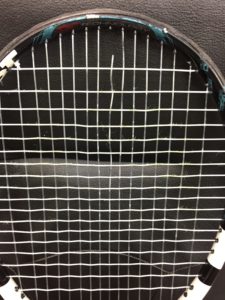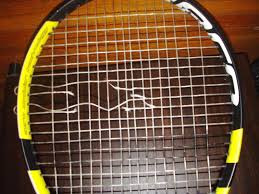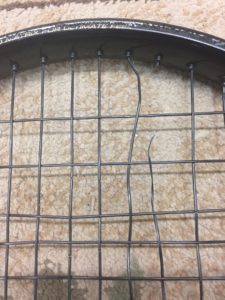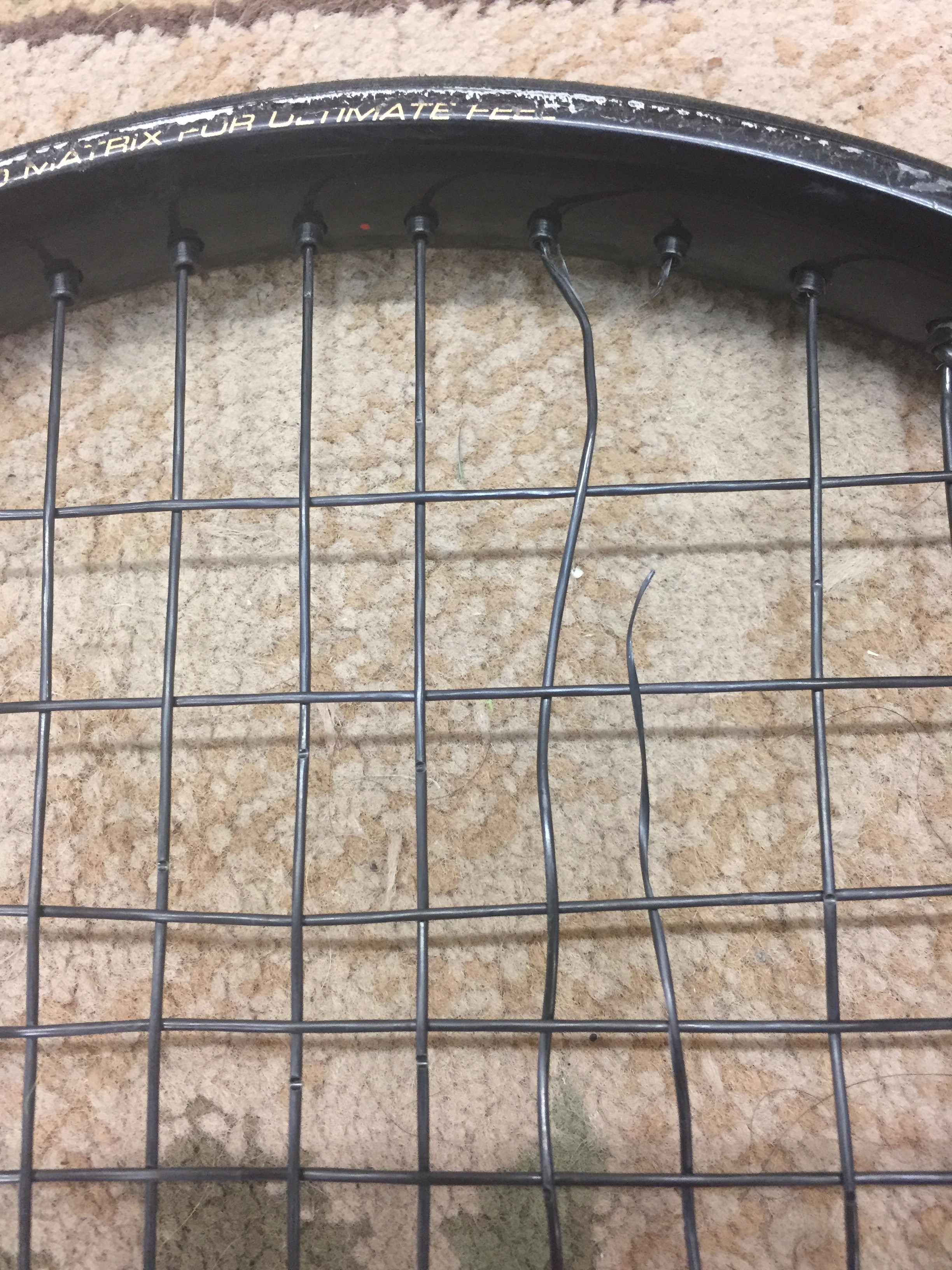Top Reasons for Premature String Breaks
There are so many reasons why strings break prematurely. Let’s take a look at some of the more common reasons for premature string breaks.
- Right racquet or wrong racquet? — Is the player using the right racquet for their style and level of play? Racquets are designed for specific playing styles primarily focusing on power, control, and most recently spin. The racquet a player uses makes a significant difference as to how long the strings will last. A competent and well-trained racquet technician is the person you should rely on for consultation when it comes to racquet selection.
- Right string? — Is the player using the right string for their playing style, level of play, and most importantly, the racquet they’re using? (see #1). In recent years manufacturers have released “Spin” racquets that have very open string patterns and these can wreak havoc on the string. Because of the factors I just mentioned, string selection should always be a top consideration and should match the player’s ability level, style of play, and the racquet they’re using.
- Thinner gauge strings — Players hitting with a lot of topspin or excessive slice should be cautious about using a thinner gauge string unless they’ve recently won the lottery and can afford to re-string every 6-10 hours of play. Using a thinner gauge string for a player with this style of play is a complete mismatch. Spin can cause strings to move a lot, especially if the string pattern of the racquet is more open than closed (as mentioned above). The strings will begin to notch at the junction where the crosses and the main strings meet due to excessive friction and before you know it, the notch has worn too thin and the string breaks.
-

String break due to framed ball Framing a ball is one of the most frequent, if not THE most frequent reason for premature string breakage. This happens when the player doesn’t strike the ball in the center of the racquet and instead, hits the ball off of the top or the side of the frame. Half of the ball collapses over the outside of the frame and half of it inflicts tremendous downward pressure on the inside of the hoop right where the string exits the grommet. Strings are not designed to take this kind of stress and they will typically snap. There’s NOTHING—repeat—NOTHING your stringer can do that will prevent the strings from breaking if this happens.
- A cheap string is another culprit. Players think they’re saving money by buying their own string but there’s no way to verify how the string was stored or how old it is. Someone who strings a LOT of racquets is going to buy strings from reputable sources and they’re going to turn that inventory over on a consistent basis. Industry-wide prices for string are consistent with typical retail keystone practices. You might be surprised to find that you’re not going to save that much money by buying your own string and paying someone to install it.
- Racquet dragging — We often see players who constantly drag the side of their racquet on the court when going for a low ball instead of bending at the knees to make the shot. This also occurs when players are 1/2 to 1 step too far from the ball and they reach out wide and hit off of the wrong foot, dipping the racquet and scraping it on the court. This will eventually wear the bumper guard down to a point where the string channel in the bumper guard (top piece) or side-channel no longer protects the string. This leaves the string exposed (raised) to a level where dragging the racquet on the court will result in scrapping the string, eventually causes it to break prematurely. This is purely down to the player’s technique and again, there’s nothing your stringer can do to prevent this.
- Old and brittle strings (see #5) can be a problem as well. String becomes brittle due to improper storage (stored in direct sunlight) or too little humidity in the air and becomes a prime candidate to break too prematurely. A professional stringer has a responsibility to maintain a high quality of string in their inventory which prevents this from ever becoming an issue.
- Racquet abuse is another one on the list. No need to explain anything here. If you’re guilty you already know it!
- Improper storage can wreak havoc with strings. How you care for your racquet can make a HUGE difference in the health of your string. If you leave the racquet in the cab of the car or in the trunk in the middle of August the strings are going to be affected by the extreme temperatures. It’s not going to hurt the racquet but it will definitely have a negative effect on your strings. So, if you’re playing tennis after work it’s advisable to take your racquet inside where the temperature is controlled as opposed to leaving it in your car. Also, think about another extreme and that’s traveling by air. It may be 80 degrees on the ground when your plane departs but once you reach 30,000 feet the temperature in the belly of that plane is much colder than you think. Don’t check your racquet with your luggage because there’s no way to be sure if the cargo compartment is temperature-controlled. If you’re going to take it with you make sure you include it as a piece of carry-on luggage.
- Stringer error — Stringers make mistakes because they’re human just like everyone else. Nicking the string or pulling the cross strings too fast can burn (notch) the main strings and set you up for short string life. It’s tempting I know, and you may think you’re saving money when one of your teammates says hey, I can string that for five bucks. The same applies to the kid on the local high school tennis team. They can do it for free if they choose to but where does that leave you when you realize the quality of that string job or your string breaks prematurely?
Here are a couple of photos that might be helpful. One shows what I call an expected string break and the other is due to player error when a ball is framed and the string shears off where it exits the grommet.




Comment (1)
Great article. You covered every possibility and more!
#4 Framing – Have you ever had a customer that denied they mishit the ball in the location of the string breakage and somehow it just broke? I guess it’s a judgement call how you handle that situation.
#10 Stringer Error – I ran into a bit of a snag when I was stringing certain polyester strings and was experiencing premature breakage. But thanks to John Gugel’s Offset Tube, it has really helped!
I found the hard way that certain polyester strings are sensitive when using a starting clamp. This would occur when clamping the string on the outside of the frame. Typically, when starting the crosses (instead using a starting knot) or when using the around the world pattern. I use the Offset Tube on all polyester and natural gut strings just to be safe and haven’t had any premature breakage since.
I got mine from Grand Slam Stringers a few years ago, but you can still get it directly from Racquet Quest LLC at https://racquetquest.tennis/2015/10/29/offset-tube/
I’m adding another reason – although not as common, it can sometimes be the “go to” reaction of players.
#11 Defective String
Most of the time it can be seen or felt when uncoiling the string set or while measuring string off a reel. Defective signs include discoloration, unraveling, nick, or roughness. If you notice any of these signs, do not use them. Instead, save and return them back to your supplier and request for credit or replacement.
In some rare cases, a defective string can break during stringing. If that happens, locate the breaking point, and secure a piece of trim tape near the broken ends of string. Remove the string from the frame and save. You could try using another set from the same batch you purchased, or from the same string reel. If it happens again, return them to back to your supplier and request for credit or replacement.
Here’s a weird story that happened to me at a pro challenger tournament. After stringing about 3 or 4 racquets for Raveena, I reached the end of her reel. She handed me a brand new reel for her subsequent racquets.
From that point on, her strings were breaking every 4-6 games while playing. It was the only reel she had with her. So, I had no choice but to keep using that reel. At that point, however, I realized the new reel of string had to be defective.
She managed to make it to the finals, but I had to restring her racquets as she broke them during the match.
Bad news . . . she lost the finals.
Good news . . . she always had a freshly-strung racquet throughout the match!